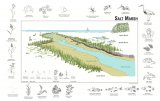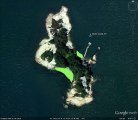Salt Marsh
SALT MARSH WHAT IS A SALT MARSH? Salt marshes form in estuaries and protected areas or bays where freshwater streams empty into the sea. This zone of mixing between fresh and salt water (known as brackish water) produces a rich and highly productive ecosystem. The dominant grasses in a salt marsh are of the genus Spartina. The large amount of food produced by both living and decaying plants provides nutrients for many young fish and crustaceans. Salt marshes are considered the nurseries of the sea.
PHYSICAL FEATURES New England salt marshes owe their structure to the glaciers of the last ice age. As the glaciers melted, the outwash water eroded numerous valleys as it flowed towards the rising sea. As sea level rose, these valleys were swamped and slowly filled with sand and gravel from the streams. Eventually the characteristic plants and animals of the salt marsh found a fertile place to settle. Salt marshes form in shallow inlets, where tidal flooding and stream currents deposit suspended sediments, gradually forming the base of the marsh. In the zone that is regularly exposed at low water, salt marsh meadow grass gains a foothold and stabilizes the shifting substrate. The roots and stems slow and trap more sediment. As the annual growth dies back in the fall, the plant bodies become partially decomposed and form a bed of peat. In well-developed marshes this peat may be several feet thick.
IMPORTANCE OF SALT MARSH HABITATS Scientists have determined that salt marshes are among the world's most productive ecosystems in terms of the sheer amount of nutrient-rich decaying plant material (detritus) they produce. With added nutrients from the ocean, salt marshes are important habitats for shellfish and coastal birds. Salt marshes are critical nursery areas for many fish, such as winter flounder, that migrate into deeper water as they get older. Nearly 70 percent of all commercially harvested fish and shellfish use estuaries at some point in the life cycles. Salt marshes also provide food and nesting sites for many species of migratory birds. In addition to the services salt marshes provide marine plants and animals, they also positively impact human life. Salt marsh bacteria clean up the environment by breaking down waste and decaying organisms. Salt marsh grasses provide natural filtration of debris and impurities that helps to neutralize and balance the ecosystem. The peat base of a salt marsh, which is quite porous, acts like a giant sponge, absorbing water during floods and storms, and thus protecting homes and property from damage.
SALT MARSH ZONES The plants in a salt marsh tend to grow in specific zones. These zones are characterized by the proportion of each tidal cycle during which they are submerged in salt water. Plants growing toward the landward side of the marsh tend to be less tolerant of salt or brackish water. Low tide exposes the tidal channels through which the sea water journeys, flooding the marsh twice a day. These marshes may have some water in them continuously. In contrast, the upper marsh may flood only during spring tides and storm tides. The Marsh Edge The marsh edge is the most landward zone. In many New England marshes, this zone is easy to recognize by the very large reed, Phragmites communis, that grows to be 10 feet high. This grass sports a flower plume resembling a feather duster that cannot tolerate much salt water. In many marshes, Phragmites is encroaching on the marsh flat as a result of the restricted circulation of sea water. Phragmites is considered a nuisance species because it out-competes other salt marsh grasses. Fresh groundwater will push back the salt water and allow the reed to grow out onto the marsh. In the landward part of this zone, we often find beach plums (Prunus maritima), staghon sumac (Rhus glabra), sea spray rose (Rosa rugosa), bayberry (Myrica pensylvanica) and a multitude of plants that live in open or disturbed areas. This zone has the highest diversity of any in the marsh.
The Upper Marsh The upper marsh is submerged only by spring tides and storm tides. The plants that live here do best in fresh water, but can tolerate the occasional dose of brackish water. The flooding by brackish water eliminates other exclusively freshwater plants. This zone is dominated by marsh elder (Iva frutescens), a shrub growing to about 3 feet tall. True grasses like spike grass (Distichlis spicata) and black grass (Juncus gerardi) and other flowering plants like seaside lavender (Limonium carolinianum), goldenrod (Solidago sp.) and aster (Aster tenuifolius) also have a strong presence in this zone. Note that only a slight elevation drop (about 6 inches) marks the change to the middle marsh.
The Middle Marsh The middle marsh is often called a salt meadow. This zone is conspicuous because of the nearly total dominance of the short, stiff salt meadow grass (Spartina patens). The marsh flat has no more than 6 inches of relief. The meadow grass turf is broken by shallow depressions in the flat called pannes. Pannes are recognizable by their thick growths of glasswort (Salicornia sp.). Glasswort removes salt from the water, storing it in special cells until the plant dies at the end of the season. This plant is often used in salads. It has a strong salty taste and is sometimes called "pickleweed." In the fall, the plant turns a brilliant red as it dies. Algae are an important part of the food chain in the marsh. Note the algae growing around the base of the grass stems. Look in the mud at the base of the grass plants. Look carefully at the stems of the grass and you may see the coffee bean snails (Melampus bidentatus). These snails have lungs and must climb the grass stems to avoid submergence.
The Lower Marsh As the elevation drops toward the tidal channels, the grass changes to salt marsh cordgrass (Spartina alterniflora). Cordgrass can grow to heights of 3-6 feet. This grass is submerged during more than half of the tidal cycle. Living at the base of the grass is a stringy green algae, called mermaid's hair (Chaetomorpha sp.). Often, the mud here has films of algae that make the surface appear greenish or golden colored. Attached to the mud by byssal threads are Atlantic ribbed mussels (Modiolus demissus). The banks of the tidal channels expose the peat base that lies under the grass beds. Look for mud snails (Nassarius obsoletus) plowing through the mud. You may see mummichogs (Fundulus heteroclitus), mosquito-larvae-eating fish, that are common to the channels. Looking out over a marsh for the first time, you may not be able to distinguish one grass from another. Two clues to identification are knowing where the grass is located in relation to amount of time it stays in the water and color. At the water's edge salt marsh cordgrass forms a dark green border, up to 6 feet tall in favorable conditions. The salt meadow grass and nearby spike grass are 1-2 feet high and form a lighter green carpet. By late summer the salt meadow grasses have bent at their bases to form flattened cowlicks.
(Adobe PDF)
NATURALIST NOTES Mosquitoes and greenhead flies do breed in salt marshes, and can make visiting quite challenging. But fish called mummichogs that live in the marshes eat mosquito larvae, keeping the populations somewhat in check. Attempts at draining marshes to eliminate mosquitoes have been unsuccessful, probably because the natural predators are cut off from the larvae. Native Americans foraged and hunted in salt marshes. Early New England settlers grazed cattle on productive salt marshes and harvested the grasses (particularly Spartina patens) for hay. Salt marshes lost their economic importance in the early 19th century when seed supplies and improved technology made upland farming more practical. Salt marshes became the neglected coastal habitat—ignored, undervalued and unappreciated. Marshes were filled, dredged, drained and sprayed with pesticides in order to build roads, houses and dumps.
SALT MARSH CONSERVATION AND RESTORATION Only now that we have destroyed many of our salt marshes have we realized what valuable services they provide for us, for the health of the world's oceans and for a variety of aquatic life. Our state and federal governments have enacted legislation to protect existing wetlands and to improve and restore degraded salt marshes. Wetlands restoration projects restore critical tidal flow, remove fill, replace wetland soils, replant native species, remove invader species (such as Phragmites), remove pollution sources and stabilize erosion.
The above text is adapted from New England Aquarium's Boston Harbor Seaside Educator's Guide
(illustrations after Cindy Lydon - NEAQ Boston Harbor Seaside Educator's Guide)

